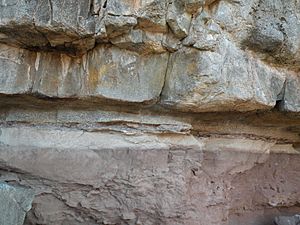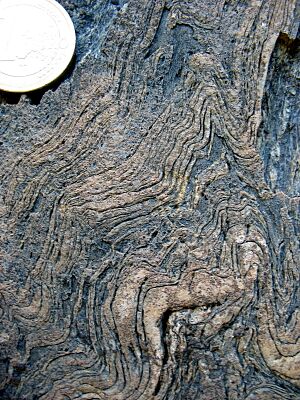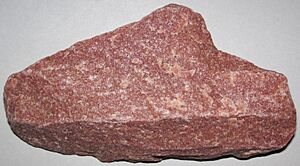Metamorphism facts for kids

Metamorphism is a big word in geology that means "change in form." It's all about how rocks change their structure, texture, or what they're made of. Rocks are solid materials made of one or more minerals that form the Earth's crust.
Scientists who study rocks are called petrologists.
Rocks are usually put into three main groups based on how they form: igneous, sedimentary, and metamorphic. Metamorphic rocks get their name because they are rocks that have changed. These changes happen because of heat, pressure, squeezing, or hot, chemical-rich fluids. Sometimes, it's a mix of all these things!
The cool part is that these changes happen while the rock stays mostly solid. Imagine a rock being perfectly happy with its surroundings. If conditions change, like when the Earth's crust moves or hot magma comes close, the rock starts to change to find a new balance. This process is called metamorphism.
Contents
How Rocks Change: Metamorphic Processes
Metamorphism is a set of natural processes that transform existing rocks. They change physically or chemically because of high temperatures, but they don't actually melt.
A Scottish scientist named James Hutton was one of the first to figure out how important heat is for making metamorphic rocks. In 1795, he wrote that some rocks in Scotland were once sedimentary, but they had been changed by intense heat.
Hutton also thought that pressure was important. His friend, James Hall, tested this idea. He put chalk into a strong metal barrel and heated it. Instead of turning into a powdery substance (which usually happens when chalk is heated in the open air), it became something like marble! This showed that pressure really does make a difference. Later, French geologists added another idea: that fluids moving through buried rock also help with metamorphism.
Rocks can change without melting because heat breaks the tiny connections between atoms. This frees the atoms to move around and form new connections. Water or other fluids in the rock can help atoms move and swap places. This allows existing minerals to recrystallize (form new crystals) or new minerals to grow. The rock changes into forms that are more stable under the new heat and pressure conditions.
Metamorphism usually starts when temperatures reach about 100 to 200 degrees Celsius (212 to 392 degrees Fahrenheit). This is hotter than boiling water! It doesn't include simple changes like when sediments get squished and turn into sedimentary rock.
The upper limit for metamorphism is when the rock starts to melt. At that point, it becomes an igneous process (like how volcanoes make new rock). The temperature at which a rock melts depends on what it's made of, the pressure, and if it has water in it. Rocks can start to melt anywhere from about 650 degrees Celsius (1,202 degrees Fahrenheit) to 1,080 degrees Celsius (1,976 degrees Fahrenheit).
Metamorphism can happen at almost any pressure, from near the Earth's surface to very deep inside, where pressures are extremely high.
Types of Metamorphism
Regional Metamorphism
Regional metamorphism is a big type of change that affects huge areas of the Earth's crust. It often happens where mountain building is taking place. It also includes burial metamorphism, which happens when rocks are simply buried very deep under the Earth's surface.
Dynamothermal Metamorphism
This type of metamorphism happens where tectonic plates crash into each other. When two continental plates or a continental plate and an island arc collide, they create huge mountain ranges. In these collision zones, the Earth's crust gets very thick. Rocks buried deep down are squeezed and heated a lot. Later, as the mountains wear away, the deeply changed metamorphic rocks are uncovered.
Rocks formed in these areas often show clear foliation. This means the rock has layers or bands. Foliation happens when the rock is squeezed from the sides during metamorphism. Tiny, flat minerals like mica and chlorite get rotated and line up, making the rock look banded. These bands often show different colors from the minerals.
A common example of a foliated rock is slate. It forms from shale (a sedimentary rock). Slate has excellent cleavage, which means it can be split into thin, flat sheets. That's why it's used for roofing tiles!
The type of foliation depends on how much the rock has changed (its metamorphic grade). For example, if you start with mudstone, it changes like this as it gets hotter:
- First, mudstone becomes slate, a very fine-grained, layered rock.
- Then, slate turns into phyllite, which is also fine-grained.
- Next, schist forms, which has medium to large grains.
- Finally, at very high temperatures, the rock becomes gneiss, which has coarse (large) grains.
Some rocks don't show foliation. For example, marble doesn't have flat minerals, so it usually doesn't form layers. This makes it great for sculptures and buildings.
Burial Metamorphism
Burial metamorphism happens simply because rocks are buried very deep. Imagine the huge weight of thousands of meters of rock layers above! This immense pressure and the heat from deep inside the Earth cause the rocks to change.
Burial metamorphism usually creates low-grade metamorphic rocks. These rocks don't show the folding or squeezing effects that are common in dynamothermal metamorphism. An example is the Sioux Quartzite found in North America.
Contact Metamorphism

Contact metamorphism happens when hot magma pushes its way into cooler surrounding rock. The heat from the magma changes the rocks right next to it. The area around the hot magma where these changes happen is called a metamorphic aureole (pronounced "OR-ee-ohl"). Rocks formed by contact metamorphism are often called hornfels. They are usually fine-grained and very tough.
The amount of change is greatest right next to the magma and gets less as you move further away. How big the aureole is depends on how hot the magma is, how big the magma body is, and how different its temperature is from the surrounding rocks. Small magma intrusions (like dikes) have tiny aureoles, but huge magma bodies (like batholiths) can have aureoles several kilometers wide!
Sometimes, hot fluids from the magma also get involved. These fluids can change the chemistry of the rocks even more. If the rock being changed is rich in carbonate, it can form a special type of rock called a skarn. These changed areas can sometimes contain valuable metal ores.
Hydrothermal Metamorphism
Hydrothermal metamorphism happens when rocks react with hot fluids. These fluids can come from magma, from groundwater circulating deep underground, or even from ocean water.
A great example is on the ocean floor. Hot fluids circulate through the basalt rocks near spreading centers (where new ocean crust is forming). These fluids eventually shoot out of vents on the ocean floor, creating "black smokers" that look like chimneys. The patterns of these changes in the rock help scientists find valuable metal deposits.
Shock Metamorphism
Shock metamorphism is pretty dramatic! It happens when an object from space, like a meteorite, crashes into the Earth's surface. The impact creates incredibly high pressure and heat for a very short time. This extreme pressure forms unique minerals and textures in the rocks, like special forms of quartz called coesite and stishovite.
Dynamic Metamorphism
Dynamic metamorphism happens in areas where rocks are under a lot of stress, like along fault zones. In these places, the physical squeezing and breaking of the rock are more important than chemical changes. The minerals in the rock might not be in perfect chemical balance, and the textures created by this type of metamorphism are very important clues for geologists.
There are different ways rocks deform mechanically. They can break and rotate (called cataclasis), individual mineral crystals can bend and flow (plastic deformation), or tiny atoms can move around. The way the rock changes depends on how deep it is, because temperature and pressure affect how it deforms.
Near the surface, fault zones might have broken, loose rock fragments. Deeper down, these fragments might be cemented together. Even deeper, where temperatures are higher, the rocks can become very hard and flinty. At depths where temperatures are over 300 degrees Celsius (572 degrees Fahrenheit), the rock starts to flow like a very thick liquid, forming a rock called mylonite. Mylonite has strong layering and a very fine grain size.
Sometimes, if the stress is incredibly fast and strong, the rock can get so hot that it briefly melts, forming a glassy rock called pseudotachylite.
Images for kids
-
A cross-polarized thin section image of a garnet-mica-schist from Salangen, Norway showing the strong strain fabric of schists. The black (isotropic) crystal is garnet, the pink-orange-yellow colored strands are muscovite mica, and the brown crystals are biotite mica. The grey and white crystals are quartz and (limited) feldspar.
See also
 In Spanish: Metamorfismo para niños
In Spanish: Metamorfismo para niños








